Palliative Medicine & Care - Juniper Publishers
Abstract
The outbreak of the novel coronavirus disease 2019 (Covid-19) has triggered various scientific investigations on potential drugs/vaccines centered on the use of old antiviral, antibiotics, and anti-inflammatory drugs as well as food supplements. Recent clinical trial and case reports have shown that the Covid-19 viral loading can be lowered by using single or combined synergistic therapeutic administration of some existing drugs such as azithromycin, lopinavir, ritonavir, teicoplanin, and ribavirin, etc. However, pure natural compounds are known to provide a rich resource for the development of antiviral drugs/vaccines due to the presence of phytochemical moiety that could target viral host, inhibit viral growth and replication in human cells. Curcumin is a natural compound that has been widely explored as an excellent bioactive agent against viral, microbial, and inflammatory infections. Also, the antioxidant as well as dietary supplementation properties of curcumin as an immune booster cannot be overemphasized. Considering the recent trends in studies on Covid-19 patients, this review explores the possibilities of employing versatile curcumin (nanoparticles or nanoemulsion) as a promising candidate to combat the ravaging spread of the disease globally.
Keywords: Curcumin powder; Nanocurcumin; Antiviral properties; Coronavirus disease; Antibiotics; Natural compound
Introduction
Severe acute respiratory syndrome (SARS) is a disease triggered by Coronaviruses (CoV). The disease is often associated with mild-severe illness based on severity and the initial symptoms experienced within 2-14 days incubation period of the virus in the host cells. The basic symptoms experienced are, but not limited to; muscular pain, headache, and fever, cough, dyspnea, and pneumonia, etc. [1]. The principal human receptor of the virus is the angiotensin-converting enzyme 2 (ACE-2) was first recognized in 2003 and the replication strategy was characteristic of the coronavirus subfamily which reduces the number of lymphocytes circulating in the blood in an infected patient [2]. Although, a series of SARS and middle east respiratory syndrome (MERS) outbreaks that directly affect human respiratory and pulmonary tracts have been witnessed in the past years. However, in December 2019, an unusual sickness resulting from a new strain of coronaviruses was identified and after series of studies on the genomic structure and replication of the virus, it was identified to belong to a class of novel β-coronaviruses [3]. Although no tangible form of medication has been discovered as a permanent drug/vaccine to inhibit the viral growth and replication in human cells, scientists and researchers all over the world are still working tooth and nail for a befitting solution.
Previous achievements in the management of the deadly contagious disease have been in the use of the already established antiviral drug. For instance, ribavirin was accepted by the U.S. FDA for emergency use authorization (EUA) for severe Covid-19 confirmed cases [4]. Also, the World Health Organization (WHO) is considering resuming clinical trials on whether the malaria drug hydroxychloroquine can effectively treat Covid-19 infection, after pausing enrollment in the study to review safety concerns about the drug [5]. More so, In vitro activity of other drugs such as Lopinavir, Ritonavir, Sarilumab, Siltuximab, Baricitinib, Anakinra, Leronlimab, Corticosteroids, Teicoplanin, Ribavirin, Sofosbuvir, Galidesivir, Tenofovir, and Triazavirin, etc. have shown promising pre-clinical efficacy in reducing the viral loading; while other therapeutic options have shown that tocilizumab, dexamethasone, and methylprednisolone has been proposed to suggestively relieve lung inflammation and decrease Covid-19 mortality [6-8]. In addition, convalescent plasma was effective in boosting strong immunity among patients with mild Covid-19. However, these therapeutic agents are still undergoing scrutiny as clinical trials for compassionate use protocols against related viral infections [9-12]. Some other studies have suggested the use of nutritional supplements either alone (e.g. Vitamin C) [13] or combined with a drug (e.g. Zinc supplements and chloroquine) in reducing the morbidity and mortality of Covid-19 [14]. Considering the pathogenesis of the virus, current attention is drifting towards the use of traditional herbal medicine and natural products as an additional arsenal to curtail the widespread of Covid-19 that have stalled economic and social activities globally [15].
Previous studies have shown that Silymarin, a polyphenolic flavonoid derived from milk thistle (Silybum marianum) could significantly inhibition of Zika virus infection with a selectivity index greater than 17 and 4 times greater than that of ribavirin used as a positive control [16]. Also, Nie et al. [17] investigated the non-toxic and dose-dependent inhibition effect of Isatidis Radix derived from glucosinolate isomers and their breakdown products against influenza A virus (H1N1). El-Fakharany et al. [18] reported that a new lectin purified from newly isolated cyanobacterium, Lyngabya confervoides MK012409 was highly effective as a therapeutic agent. The new compound showed antiviral potency against HSV-1 with EC50 of 167 ± 0.52ng/ml and subdued the formation of plaque in the HSV-1 infected Vero cells with EC50 of 84.94 ± 0.34ng/ml. Additionally, Çapcı Karagöz et al. [19] opined that the hybridization of natural compounds provides wider potentials to further improve their activities and produce synergistic effects between linked molecular structures responsible for a particular biological or pharmacological interaction.
Therefore, the objective of this review is to highlight the multibioactive functionality of curcumin as a natural compound with antioxidant, antiviral, anti-inflammatory, and antibiotic properties to complement existing monotherapy or combined therapy for Covid-19 management.
Mode of Transmission and Mechanism of Covid-19 Attachment to the Cells
Covid-19 are the largest group of viruses that can infect mammals and mammal-like species. This envelope-like pathogen is made up of spike glycoprotein deriving its name from the Latin word “corona” which means “crown” or “wreath” (Figure 1) [20]. This class of viruses is divided into α-, β-, γ-, and δ- genera based on their genomic structure with α and β coronaviruses infecting predominantly mammals [21]. Although coronaviruses are of zoonotic origin; the recent outbreak of the virus is believed to originated from the Hunan seafood market in Wuhan city of China and has grown to become an on-going pandemic [22]. Generally, the virus has significantly affected global economies, thereby forcing countries and territories to implement stern lockdown and controlled movement to contain the wide-spread of the virus [23]. A study on the genomic sequence of Covid-19 reveals 88% identity and similarity with two bat-derived SARS-like coronaviruses, thus, suggesting bats as a potential link between Covid-19 and humans [24].
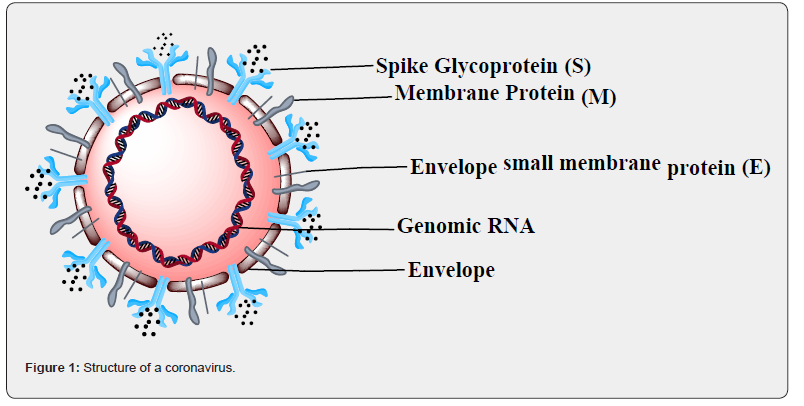
Initial investigations reported that transmission between humans began among family members after a thorough examination of 1099 patients with laboratory-confirmed cases of Covid-19. Their results revealed that 1.9% of the patients had direct contact with wildlife, 72.3% had contact with residents of Wuhan, including 31.3% who had visited the Wuhan city [25]. Also, the transmission of the disease from one person to another is possible via direct contact or by droplets released from the cough or sneeze of an infected individual. Possibly, indirect contact with infected surfaces exposed in an environment is likely to happen through nose, mouth, or conjunctiva [26]. However, a likely fecaloral transmission route has also been revealed to be plausible [27].
The early clinical symptoms due to Covid-19 infection are fever, dry cough, and fatigue. Other possible symptoms like nasal congestion, runny nose, sore throat, and diarrhea have also been identified [28]. Whereas, acute respiratory distress syndrome (ARDS), shock, multiple organ dysfunction syndromes (MODS), and fulminant myocarditis are likely to occur at chronic conditions [29,30]. The life cycle stages of coronaviruses are such that when they are inhaled into the host respiratory organs, firstly, they attach to the host receptors, and enters the host cells through endocytosis (penetration) (Figure 2). After the discharging of the viral content in the host cells, the viral RNA proceeds to the nucleus for replication, while the viral mRNA is utilized for biosynthesis of viral proteins. Thereafter, new viral particles are produced (maturation) and released [31]. Once released in the human host cell, the virus binds to the ACE2 (viral receptor) which is found at higher concentrations in the ileum and colon and regulates intestinal inflammation [32]. The ACE2 directly affects the gut microbiome, and indirectly cause cardiopulmonary risk [33]. This occurrence is in accordance with the published study of Guo et al. [34] suggesting that the gut microbiota may underlie the predisposition of healthy individuals to Covid-19.
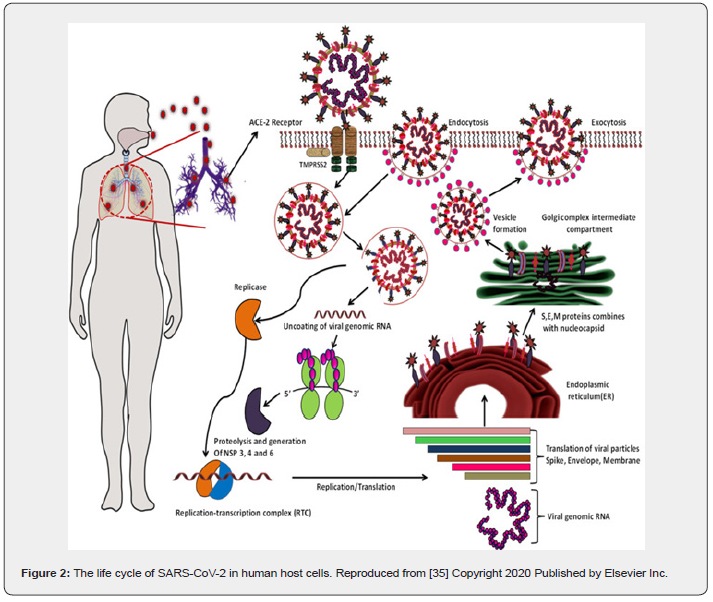
Curcumin: Chemistry and Pharmacokinetics
Curcumin is a natural polyphenolic compound present in the plant Curcuma longa, a rhizome that is popularly known as turmeric. This yellow powdered substance belongs to the Zingiberaceae family, with a long history of being used as a spice for cooking numerous spicy dishes in different countries [35,36]. Curcumin is a highly conjugated compound that can appear in two forms: the keto and enol form (Figure 3). The two forms of the compound can easily be interconverted by a phenomenon referred to as keto-enol tautomerism which involves the movement of a hydrogen atom and rearrangement of the bonding electrons.
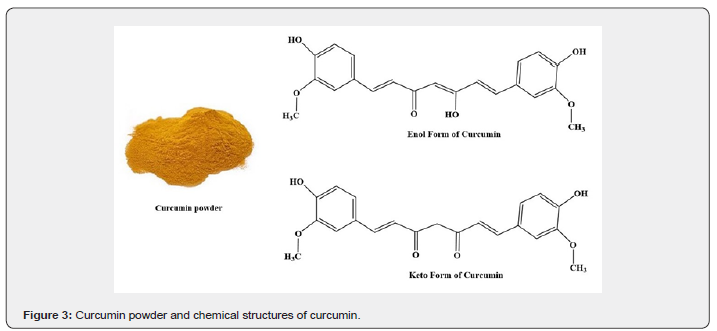
The diarylheptanoid (Curcumin) has shown a lot of remarkable benefits to human health since the plant-based bioactive extract has recorded marked anti-fungal, anti-inflammatory, antioxidant, and antibiotic activity against human bacteria and pathogenic diseases [37]. The Food and Drug Administration (FDA) has declared curcumin to be generally safe and non-toxic, thus, it has been used extensively in Ayurveda, Siddha medicine, and traditional Chinese medicines [38]. Moreover, curcumin is chemically unstable when exposed to alkaline, heat, oxygen, or light [39,40]. The aqueous solubility, absorption, and biological activities of curcumin decrease drastically through degradation in the gastrointestinal tract (GIT). Potential approaches including chemical conjugation to obtain curcumin prodrugs [41] and encapsulation of curcumin into nanoparticulate formulations [42,43] have been used to overcome these shortcomings.
A low trace of curcumin in blood has been reported in its pharmacokinetics and a good percentage is excreted in feces. Cell biologists suggest that curcumin can disorganize the Actin network leading to the destabilization of filaments [44]. According to Dhar et al. [44], curcumin binds closely to the cytochalasin binding site of Actin revealing possible allosteric effects with its binding at the barbed ends of actin to the pointed end where possible disruption of interactions with filament formation occurs with the adjacent actin monomer.
A novel workable hypothesis suggesting the potentials of curcumin in curing gut infections has shown that gut microflora could be the likely therapeutic target since curcumin acts indirectly on the brain mediating gut microflora with the brain axis, a complex two-way system that preserves the health of the brain [45]. The mode of action within the gut–liver axis i.e. the effect of curcumin begins in the gut and to a lower concentration in the liver, thereby leading to their utilization in interrupting gut infections such as Covid-19 [46]. For example, considering the recent pandemic, curcumin could act in a vertical pathway of the alimentary canal to inhibit the early phase of infection. Following gut infection of Covid-19, it is plausible that curcumin could have the potentials of inactivating the viral agent even before sliding into the vital organ (the lungs) where secondary infection and possible death may occur (Figure 4).
Biological Roles of Curcumin
Curcumin is a multi-bioactive compound with the ability to produce multiple effects from a single gene. Thus, it is highly biocompatible and can interact with a large number of biological targets molecules such as proteins, enzymes, DNA, RNA, and carrier molecules [47]. More so, it can interact with other molecular species via hydrophobic interactions, ϖ-ϖ interactions, hydrogen bonding, complexation with metal ions (chelation), and covalent bonding towards the development of new compounds [48,49]. These properties, amongst others, provide an interface for curcumin to exert its multi-functional biological activities either by directly binding with the receptors or indirectly, up- or down-regulating them [50]. For example, Cao et al. [51] found that curcumin can efficiently improve hydrogen peroxide-induced oxidative stress, intestinal epithelial barrier injury, and mitochondrial damage in porcine intestinal epithelial cells (IPEC-J2 cells) in a PTEN-induced putative kinase (PINK1)- Parkin mitophagy dependent way. Also, the synergistic activity of curcumin with azithromycin and gentamycin has been reported to drastically reduce the minimum inhibitory concentration of P. aeruginosa, PAO1 [52]. Halevas et al. [52] presented two biologically active novel complex assemblies of Cu(II) with curcumin and quercetin and the ancillary aromatic chelator 2,2’ -bipyridine that displayed good antioxidant potential, strong 2,2-diphenyl-1-picryl-hydrazyl-hydrate (DPPH) scavenging activity, and improved plasmid DNA binding/cleavage properties [53].
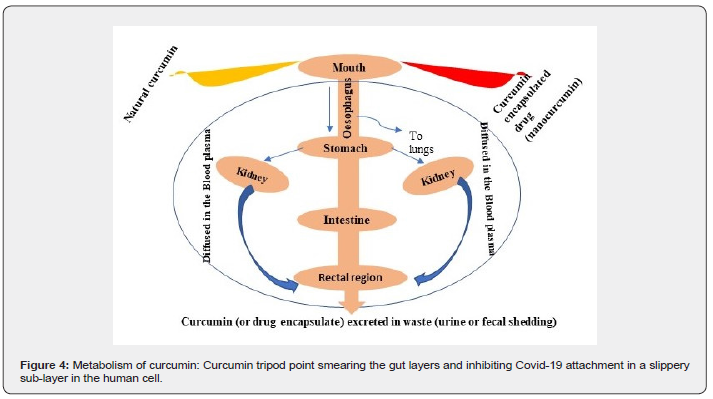
The anti-inflammatory potentials of curcumin on Concanavalin A induced hepatitis, and its molecular mechanisms in mice were elucidated by Tu et al. [54]. The study demonstrated that curcumin pretreatment reduced intrahepatic expression of genes encoding pro-inflammatory molecules and Toll-like receptor (TLR) 2, TLR4, and TLR9 mRNA or protein in liver tissues coupled with an amplified anti-inflammatory cytokine interleukin 10 (IL-10) by enzyme-linked immunosorbent assay (ELISA). Besides, Curcumin has shown multiple beneficial effects and clinical significance in many biological applications. Thus, Hu et al. [55] investigated and elucidated the cardiac therapeutic potential of curcumin on human ether-a-go-go related gene (hERG) K+ channels [55]. After performing a whole-cell patch-clamp experimental procedure, the authors noticed that curcumin could inhibit hERG K+ currents in HEK293 cells firmly by expressing hERG channels in a dosedependent manner, with an IC50 value of 5.55μM. In addition, curcumin is a coloring material and spice that has been used as dietary supplements in many dishes due to its antioxidant activity that enables tissue distribution in the intestine and detoxifying of enzymes [56].
Antiviral Efficacy of Curcumin
Over the years, curcumin has been extensively used in traditional medicine as a potent antiviral agent against several prevalent viral outbreaks including dengue virus and hepatitis C virus, etc. A study conducted by Chen et al. [57] shows that curcumin could inhibit envelope-liked viruses including the influenza virus by using sulforhodamine B-containing liposomes that mimics the viral envelope, thereby disrupting the integrity of the membranes of viral envelopes and liposomes. According to Mounce et al. [58], patients infected with Zika and Chikungunya (CHIKV) viruses were responsive to the treatment of cells with about 5μm curcumin without any impact on cellular viability. This implies reduced viral infectivity in a dose- and time-dependent manner after curcumin intake. Also, Von Rhein et al. [59] observed the broad antiviral activity of curcumin or Boswellia serrata gum resin extract against CHIKV and discovered that the compounds effectively blocked the entry of CHIKV Env-pseudo typed lentiviral vectors and inhibited CHIKV infection and vesicular stomatitis virus vector particles In vitro to the same extent. Studies on herpes simplex virus type 1 (HSV-1) by Kutluay et al. [60] show that curcumin significantly inhibits the transcriptional coactivator proteins p300 and CBP, blocked viral infection and gene expression as well as diminish the replication of RNA polymerase II to immediate-early promoters effectively. Also, the anti-influenza activity of curcumin examined in H1N1 and H6N1 subtype cell cultures reveal that 30μM curcumin reduced the yield of the virus by over 90% while the EC50 determined using plaque reduction assays was ~ 0.47μM using a selective index of 92.5 [61].
The investigations performed by Qin et al. [62] show that curcumin expressively reduces the synthesis of viral RNA, the expression of viral protein, and the overall production of viral progeny in Vero cells infected with EV71. The authors also iterated that the antioxidant property of curcumin played no role in its antiviral activity, since the antioxidant moiety (i.e., N-acetyl-L-cysteine) was unable to reduce viral replication. More so, Nelson et al. [63] classified curcumin as both a PAINS (panassay interference compounds) and an IMPS (invalid metabolic panaceas) candidate based on the often-false positive results obtained in high-throughput screens. Nevertheless, Li et al. [64] opined that curcumin is not a PAINS, but an inhibitor to APE1 redox function that affects several genes and pathways. Proving the concept, they demonstrated that curcumin can effectively block Kaposi’s sarcoma-associated herpesvirus replication and inhibit the pathogenic processes of angiogenesis and cell invasion. Additionally, the synergistic effects of thymoquinone and curcumin can substantially enhance immune response and suppress the pathogenicity of influenza viruses (H9N2) after an examination in poultry Turkey [65].
Curcumin Nanoparticles
The use of curcumin nanoparticles has been an approach to tackle the challenge of bioavailability of curcumin due to its poor solubility in various media. Based on these, Homayouni et al. [66] examined the antisolvent crystallization followed by a freeze-drying technique for synthesizing curcumin nanoparticles (Cur-NPs). Cur-NPs prepared with different ratios of hydrophilic polymers (poloxamer 188 and soluplus) and high-pressure homogenization displayed remarkable solubility and dissolution rate compared with original curcumin. Also, Mohammadian et al. [67] reported that protein nanofibrils (WPN) could be employed as carriers to improve the aqueous solubility of curcumin up to 1200-folds in acidic conditions (pH 3.2) for the design of new functional food emulsions and beverages. Also, Páez-Hernández et al. [68] prepared curcumin nanoemulsions bearing low polydispersity index, negative zeta potentials, and small droplet sizes by ultrasonication and microfluidization methods involving the dissolution of curcumin in different oils like medium-chain triglycerides (MCT), grapeseed, or olive oil. These nanosized materials could be employed against Covid-19 that could also be transmitted via droplets. Furthermore, the antimicrobial efficacy of platinum conjugated curcumin (C-PtNPs) was shown to exhibit higher activity for decreased production of collagen by NIH/3 T3 cells due to hepatic fibrosis as demonstrated by Yu et al. [69]. In another investigative study, Song et al. [70] documented the harmonious antibacterial effects of curcumin modified silver nanoparticles (cAgNPs) on E. coli and B. subtilis by exploring reactive oxygen species, ROS-mediated pathway based on growth curve and surface plate assay.
The obtained results showed that the bacteria inhibitory effect and death were achievable by the generation of more ROS which led to membrane damage, bacterial lipases, and induce the outflow of intracellular contents (Figure 5) [70]. Additionally, Acevedo-Guevara and coworkers [71] designed modified banana starch nanoparticles with particle sizes lower than 250nm and encapsulation efficiency above 80% for the controlled release of curcumin in simulated gastric and intestinal fluids. Recent studies by Caldas et al. [72] shows the successful loading of curcumin into polymeric systems containing maltoheptaoseblock- polyisoprene (MH-b-PI3.8kDa). The charged Cur-NPs possessing an entrapment efficiency of ca. 70% were employed for the delivery of curcumin with high stability into simulated gastric and intestinal fluids. Youssouf et al. [73] also reported the encapsulation of curcumin onto nano-micelles developed from the grafting of polycaprolactone (PCL) chains with oligocarrageenans using a protection/deprotection technique. The non-cytotoxic nanocarrier induced the uptake of curcumin by endothelial EAhy926 cells and also augmented the anti-inflammatory effect of curcumin in TNF-alpha-induced inflammation experiments. An innovative smart and self-fluorescent drug nanocarriers with imaging properties were fabricated by Xu et al. [74] by utilizing curcumin gatekeeper on a templated mesoporous silica nanoparticles (MSN) possessing large pores to deliver FDA approved pluronic polymer, F127 [74]. The In vitro drug release profiles showed that curcumin could be confined in the pores at pH 7.4 when there is no GSH. However, with GSH at pH 5.5, curcumin was successfully released via the hydrolysis of β-thioesters (Figure 6). Additionally, Yao et al. [75] demonstrated In vitro antioxidant capacity of curcumin after exposure to a simulated gastrointestinal tract (GIT) which was improved via loading with zein nanoparticles. This activity was demonstrated much stronger by 2, 2’-azino-bis (3- ethyl-benzothiazoline-6- sulfonic acid) diammonium salt (ABTS+) radical scavenging and ferric ion reducing power.
Conclusion and Outlook
Covid-19 is a class of severe acute respiratory syndrome with high transmission power. Recent studies have iterated that the gastrointestinal tract could serve as an alternative route of further infection. However, with the high prevalence and mechanisms of Covid-19 infection on the rise, crucial prevention measures have been defined, and search for clinically approved palliative is ongoing. In this review, we have shown the multi-functional biological efficacy of curcumin against organisms including different strands of bacteria and viruses. The antioxidant activity of dietary supplementation of curcumin has been shown to boost immunity and allows tissue distribution in the intestine and detoxification activity of enzymes. Also, the synergistic efficacy of curcumin with other drugs has been established to enhance its biological activity in In-vivo and In vitro studies. Although the bioavailability and poor solubility of curcumin have been quite challenging, however, the preparation of curcumin nanoparticles has proven to overcome these shortcomings. Additionally, curcumin is biocompatible as it can interact with a large number of biological targets such as proteins, enzymes, DNA, RNA, and carrier molecules. More so, it can combine with other molecules (including existing clinical trial drugs) via hydrophobic interactions, ϖ-ϖ interactions, hydrogen bonding, metal chelation/ complexation, and covalent bonding for the easy fabrication of new compounds. Thus, considering the mode of transmission and viral replication sequence of coronaviruses, curcumin nanoparticles or nanoemulsion derived from the interaction with other materials (such as drug molecules, polymeric compounds, etc.) could be used to design novel innovative compounds that can be employed against Covid-19.
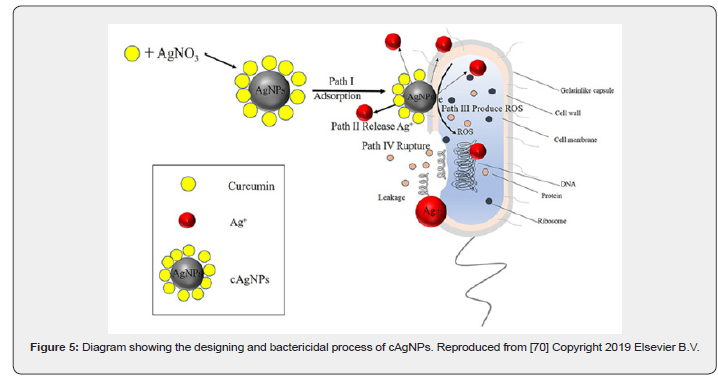
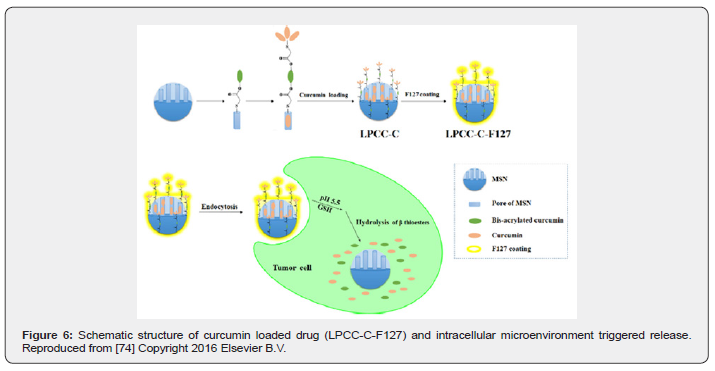
To Know more about Palliative Medicine & Care
Click here: https://juniperpublishers.com/index.php





No comments:
Post a Comment